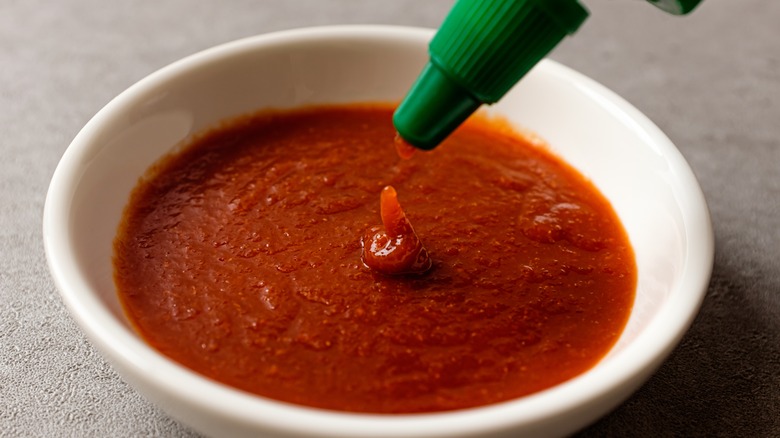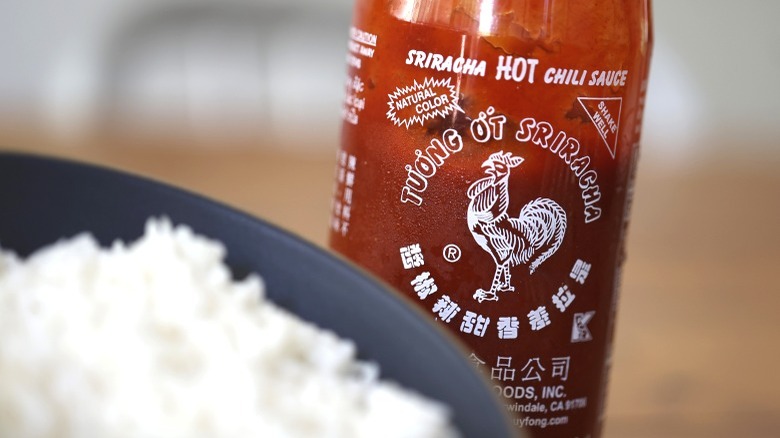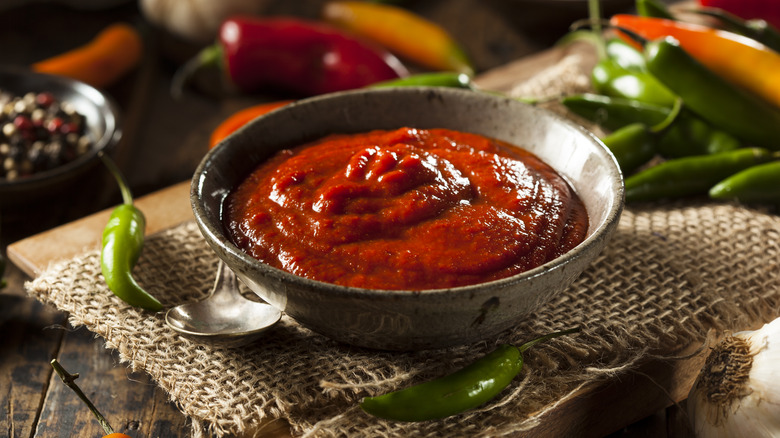Should You Store Sriracha In The Fridge Or On The Counter?
A ton of home cooks and pro chefs alike swear by sriracha, a hot sauce with Thai origins that has exploded in popularity across the United States over the past two decades. Just a drizzle of this tangy, spicy condiment can elevate chicken wings, noodle soups, stir-fries, rice bowls, and more. To get the most out of this sauce, you'll want to start stowing your sriracha in the fridge — even if many cooks (and restaurants, for that matter) get away with leaving their bottles out on the table.
Chili peppers are obviously the main ingredient in sriracha, and even after they're blended into the sauce, they are not immune to aging. Exposure to air and sunlight will accelerate the oxidation of your sauce, which will slowly make it darken in color while the taste lose some of its intensity. If you've noticed that half-used bottles of sriracha in restaurants have a duller hue, while newer ones at the grocery store look bright, it's because those fresh bottles have spent less time out in the open.
Refrigeration slows down the aging and oxidization process by keeping your bottle cold and away from light. Therefore, your chili sauce stays vibrant and tasty, without any premature aging going on. However, the question of when sriracha actually becomes unsafe to eat can be complicated.
Sriracha can spoil, but it takes a very long time to do so
While refrigeration can really make a difference in the quality of your sriracha, it doesn't make that much an impact when it comes to preventing spoilage. Chili peppers are naturally resistant to microbes due to their high levels of capsaicin, the chemical that gives them their spiciness. A bottle of sriracha also contains plenty of vinegar and salt, two ingredients that hinder the growth of mold and bacteria. This strong presence of acid and sodium in most hot sauces explains why they can be kept in the pantry without a problem.
Homemade sriracha is the exception to this rule, as it doesn't come with any industrial preservatives. However, commercially-produced sriracha can still spoil if treated improperly. After every use, make sure to completely screw the nozzle or lid of your hot sauce shut, so that external pathogens are less likely to infiltrate your bottle. If you want to play things on the safe side, the U.S. Department of Agriculture recommends refrigerating and using up all chili sauces within six months after opening. Take rancid flavors, changes in consistency, and mold spots or suspicious specks as signs of spoilage in your sriracha.
Other tips to preserve and use up your sriracha
Freezing is another way to make sriracha last longer, but it won't be as easy as popping a bottle into the fridge. To put this hot sauce into cold storage, you'll have to transfer it into an ice cube tray and then put the cubes in an airtight container. This allows you to freeze this condiment into small portions, which will be easier to measure out and defrost than a giant block of sauce. However, freezing can make sriracha's texture turn gritty, so only use it as a last resort.
If you're looking to finish up a bottle of sriracha before it goes bad, you'll have to use it more creatively. Instead of just drizzling this chili sauce on top of your food, start mixing it into marinades, stews, and soups. The spicy sauce will dissolve into most liquids, giving your food a subtle heat and garlicky bite that will not overpower other flavors. You can also combine it with mayonnaise to create your own Bang Bang sauce, which can be used as either a rich dressing or a delectable dipping sauce.
You also don't have to just "eat" this hot sauce, either. Many people don't know that sriracha pairs excellently with alcoholic beverages, especially when used in spicy mixed drinks such as a michelada or a Bloody Mary. Mix it into citrusy drinks or ones that already call for hot ingredients, like a spicy margarita.



